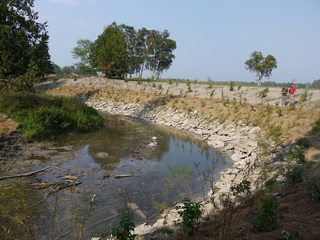Mindemoya River - Sites MIN-308 & MIN-310

This rehabilitation consisted of bank restoration and joint vegetative plantings. The approved plans consisted of the re-grading of the north bank, the creation of a bench to allow for further cross sectional flow area, and the placement of vegetated stone bank protection.
Additional tree plantings were planted on the top of the bank and the downstream bank leading out of the site which was generally lacking any riparian or canopy zones. Further floodplain plantings consisted of various woody plants (bushes and trees). Soil stabilization consists of coir fabric and ground cover. Fish passage potential has been enhanced as a result of rehabilitation. Flow conditions are varied due to the presence of the local riffles and the pool. Transitions do not present any form of barrier.
The rehabilitation of site MIN-310 involved the restoration of the following bank features along an approximately 80 m reach of the Mindemoya River: 540 sq. meters of bank grading, 280 cubic meters stone protection at the bottom of the bank, seed mix of 195 sq. meters, Coir matting +/- 500 sq. meters, 65 meters of cedar split rail installed to restrict livestock from the river, total trees and shrubs are 2055;
A total of 1560 sq metres of shoreline protected, stabilized improved and/or retired from agricultural use. This project had 7 volunteers from the Board of Directors of Manitoulin Streams participate in planning and actively volunteering at rehabilitation sites. The total number of hours volunteered for this site is 51.4.
A total of 34 other volunteers contributed mainly by tree planting and fence building. The landowner and family contributed 46 hrs of labour and 7 hrs of attending meetings. Funding contributions toward the construction of the project include CFWIP, COA and NOHFC.
Additional tree plantings were planted on the top of the bank and the downstream bank leading out of the site which was generally lacking any riparian or canopy zones. Further floodplain plantings consisted of various woody plants (bushes and trees). Soil stabilization consists of coir fabric and ground cover. Fish passage potential has been enhanced as a result of rehabilitation. Flow conditions are varied due to the presence of the local riffles and the pool. Transitions do not present any form of barrier.
The rehabilitation of site MIN-310 involved the restoration of the following bank features along an approximately 80 m reach of the Mindemoya River: 540 sq. meters of bank grading, 280 cubic meters stone protection at the bottom of the bank, seed mix of 195 sq. meters, Coir matting +/- 500 sq. meters, 65 meters of cedar split rail installed to restrict livestock from the river, total trees and shrubs are 2055;
- Potted shrubs 450
- Potted trees 105
- Bare root trees 250
- Bare root shrubs 250
- 1000 tree plugs of various species.
A total of 1560 sq metres of shoreline protected, stabilized improved and/or retired from agricultural use. This project had 7 volunteers from the Board of Directors of Manitoulin Streams participate in planning and actively volunteering at rehabilitation sites. The total number of hours volunteered for this site is 51.4.
A total of 34 other volunteers contributed mainly by tree planting and fence building. The landowner and family contributed 46 hrs of labour and 7 hrs of attending meetings. Funding contributions toward the construction of the project include CFWIP, COA and NOHFC.

